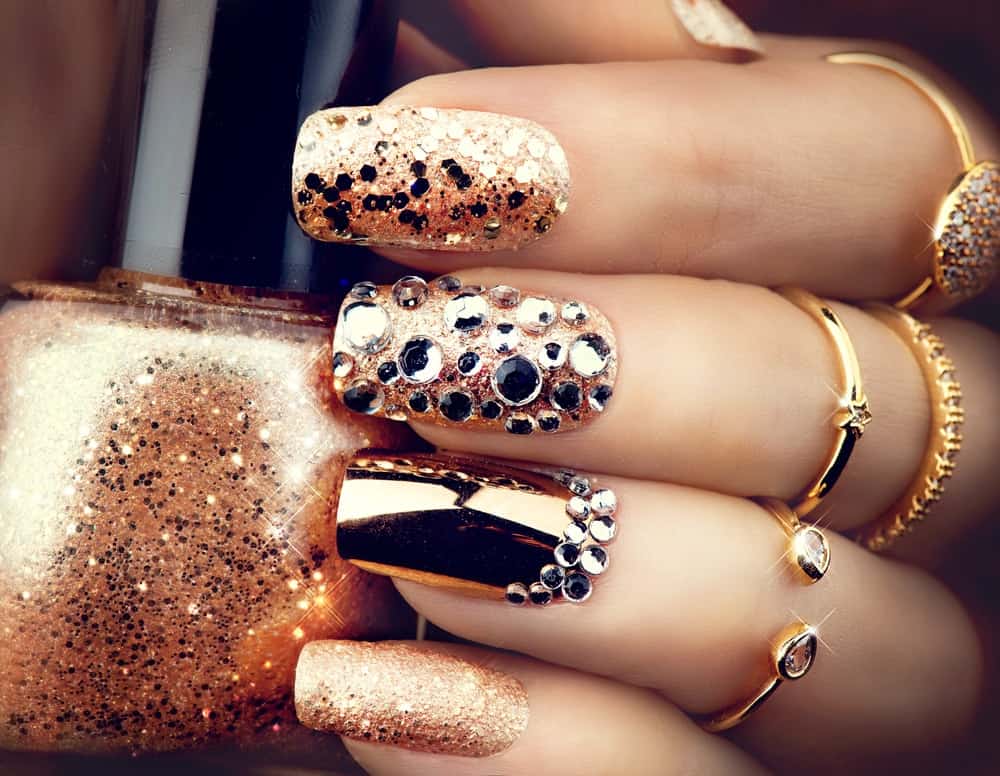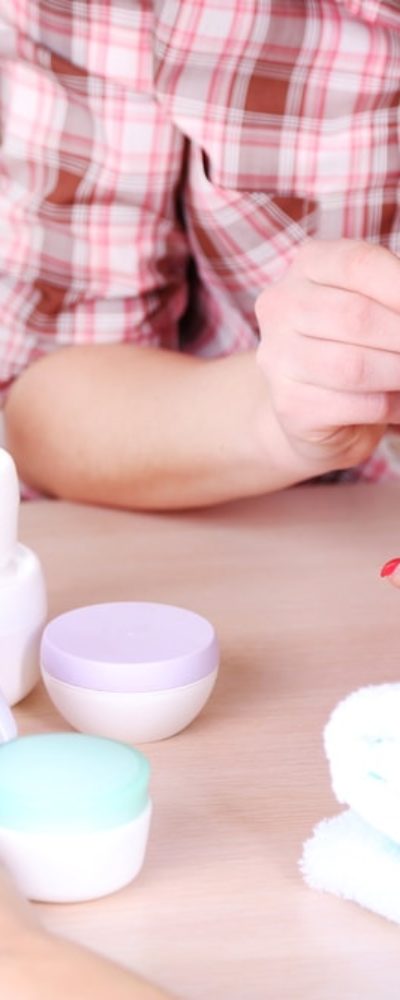There’s nothing better than getting a beautiful nail job and then going swimming, and then finding out your expensive nails have chipped or dissolved off into the water. Wait, no that’s terrible – nobody wants that! Traditional nail treatments don’t stand up to the rigors of chlorinate water very well, typically losing their luster after one afternoon poolside (assuming at some point you went pool-in).
So you want to swim but you don’t want to waste the effort, time and money on a nail job at the same time. Maybe you’ve had gel nails or have heard of them and their seemingly wondrous lasting power. Gel nails are structurally more durable than traditional nails, and they’re not nearly as prone to chipping, but can they stand up to morning swimming laps or an afternoon flirting with an accent in Bermuda shorts?
It seems like it might depend on some factors – the quality of the gel nails themselves, the type of activity in which you’re partaking in the pool and the chemicals that contact your mani. Let’s look at some reasons why you’d want gel nails for water fun over regular nail polish and some safeguards to protect your nails no matter what type of manicure you have.
Can you go swimming with gel nails?
Well yes, of course, you can – you can do anything you want all the time, don’t let anyone stop you. But you’re a smart cookie, and we both know that’s not what you meant; you want to know if they’ll stay in place and why. Well, there are some major differences between regular nail polish and gel nails to look at first, but before we even look at that, let’s see why swimming and manicures don’t mix well, generally.
Let’s look at some dangers to your traditional manicure lurking in the partaking of pool parties.
Water
Just simply getting your nails wet for prolonged periods of time when they’re treated using regular nail polish can damage them. Regular nail polish isn’t typically waterproof and so it gets into the space between the polish and your natural nails. This can cause the coat of polish to break down, wash off or simply become more brittle. Brittle treatments will chip and wear away dramatically fast – one long afternoon in the water is all it takes to break down the coverage of traditional nail polish and then it’s back to the salon.
Chlorine
The price we pay for not getting diseases from our pools has a name, and that name is chlorine. While it might largely keep us safe from waterborne pathogens, this chemical likes to obliterate nail polish. Chlorine makes nails more brittle, and if it gets underneath your polish, it will weaken bonds and just ruin them entirely. Finally, exposure to chlorine – even briefly – will fade colors used in lacquers and acrylics, something you obviously want to avoid.
Salt
If you are of the beach-going variety, the salt in ocean water will ruin your nails as well. It tends to stick in extremely fine layers on your skin and nails, and when it drys, it causes cracks and whitening that ruin your manicure. You can lessen this damage by washing off immediately after dipping in the sea, but even a short-term dip at the beach can inflict fatal damage on your nail job.
Other chemicals
Naturally you want to use suntan lotion because looking like a handbag isn’t in fashion like, ever, but cream sunscreens can wreak havoc on your nails as well. With traditional nail polishes, the chemicals in sunscreen bind with the paints and make an almost gluey, puffy mess, completely ruining them.
These aren’t the only reasons why your regular nail polish fails you in the water, but they’re the most likely ones to ruin your day. How do gel nails stand up to these threats? Let’s find out:
What makes gel nails better when swimming?
Gel nails are, as we stated before, sturdier in general than regular nail polish. They’re less prone to cracking, less likely to be damaged by impact and typically the only place where water might penetrate them is at the cuticle. This makes them simply more durable, especially when it comes to fun in the pool (or beach or large bucket of rainwater, whatever floats your boat). But how do they fare specifically to the manicure threats we listed above?
Water
Because the only point of attack is that cuticle edge, water is not as big of a threat to gel nails as it is to regular polish. Depending on how skilled your manicurist is, even the cuticle point might not leave much space for water to intrude. Additionally, and perhaps most importantly, gel nails are water-repellant. They won’t fade or dissolve in the pool the way that lacquers or acrylics will.
Still, if you’re concerned about your gel nails getting water between them and the nail bed, it’s worth putting a top coat over them to really create a watertight seal. This will ensure no unfortunate worst-case scenarios.
Chlorine
Chlorine is still dangerous to gel nails, as it can weaken them and make them gummy, but they need to be exposed to chlorine longer than regular nail polish to cause similar damage. This is another spot where a good topcoat will almost completely negate your risk. Wash your hands especially well after chlorine exposure, and it’s also worth investing in a fresh manicure if you know you’re going to be poolside very soon, like gel nails weaken over time.
Salt
Like chlorine, a good top coat will keep salt from getting all up in your business. Salt makes gel nails discolor and can weaken them, but not to the degree it does to regular nail polishes. Still, make sure that you’re taking precautions if you’re going to be in the ocean.
Other chemicals
Sunscreen doesn’t seem to have the same effect on gel nails as it does on regular manis. Still, if your nails aren’t done well, it can weaken the bond and create peeling, which you’d want to avoid. You can cover your fingertips while you apply sunscreen or simply use spray-ons like we suggested above.
In general, gel nails are simply more durable, less prone to chipping, flaking, peeling or discoloration than regular nail polishes and last longer, even when exposed to water and all associated chemicals. But what if you simply don’t like gel nails, or just strongly prefer acrylics or lacquers?
There are some steps you can take to make any day at the beach perfectly fine for your nails.
Alternatives to gel nails when swimming
Maybe you don’t like gel nails? We get it – here are some alternative ways you can style and prep regular polish treatments that are resistant to swim damage but avoid gel nails.
Go with glitter
Glitter polish is stronger and denser than regular nail polish, and a topcoat of that will help strengthen your manicure. It also will protect your nails from chlorine much better than regular paint.
Dry and protect
Letting your nails dry completely between each coat will help strengthen the overall manicure. This is because when you add more polish on top of a semi-wet product already in place, they mix up and cannot form as strong of a bond. This leads to chipping and peeling.
Dry nails completely, add a new layer and when you’re done, add a topcoat. Then, each time you go to the pool, apply another thin layer of clear polish, which will keep your nails sealed and protected.
How to protect your nails when swimming
It might not be practical or desirable to always have to get gel nails. If you’re the kind of person who likes to swim for exercise or you’re an athlete, you’re going to be in the water significantly more than the average person. The following tips are designed to help make sure any manicure stands up to the rigors of regular swimming and water exposure.
Give your nails an ice water bath
Right after administering the polish, submerge your fingers into an ice water bath for roughly 5 minutes. This shrinks the tiny molecular space in the paint, making it harder for water to get in there and creating a finish that’s denser and therefore more durable.
Apply the polish in a few, thin layers
Again working with the intention of keeping your manicure dense and strong, just a few thin layers makes them less prone to chipping. Thick amounts of nail polish might seem to be stronger, but they’re far more likely to chip and crack in the water (and just in general).
Give them a wash and a rest
Unless you’re at a swim meet and need to be in the pool all day, it’s worth hopping out and washing them off from time to time before heading back in. This is especially true for chlorinated or saltwater. Prolonged exposure gets exponentially worse as time goes on, and the longer the exposure without a break, the more damage is done.
Cuticle oil is your friend
Applying a thin layer of cuticle oil before and after you swim can help repel water that seeks to get between your nail bed and your manicure. Just make sure that if you’re in chlorinated or salt water, you’re washing your hands thoroughly with soap and water afterward or the cuticle oil will not do its job correctly.
Touch up
After washing, drying and oiling your nails and cuticles, the last thing to do as you end your day in the pool is touch-up your nails. This helps restrengthen the paint and stop damage from continuing. If continuous, prolonged exposure to water is going to be a thing, then you should also be getting manicures more frequently to make sure everything stays beautiful.









